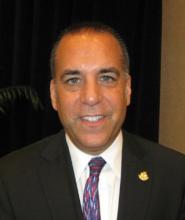Patients with large-vessel, anterior circulation ischemic stroke who underwent pretreatment neuroimaging to identify favorable penumbral patterns had similar clinical outcomes after treatment with either embolectomy or standard medical care regardless of the imaging results in the MR RESCUE trial.
"MR RESCUE underscores the importance of confirming hypotheses in randomized, controlled trials prior to implementing treatment approaches in clinical practice," co-primary investigator Dr. Chelsea Kidwell said during a late-breaking plenary session at the International Stroke Conference.
Possible reasons for the results are low recanalization rates with less-effective, first-generation devices (Merci Retriever or Penumbra System), the introduction of two imaging modalities, and the potential for favorable outcomes in penumbral patients regardless of treatment due to sufficient perfusion through collateral vessels. Another possibility is that the penumbral imaging selection hypothesis is flawed as currently conceived, she said.
The MR RESCUE (Mechanical Retrieval and Recanalization of Stroke Clots Using Embolectomy) investigators hypothesized that CT or MRI would identify patients with a favorable penumbral pattern – defined as a predicted infarct core of 90 mL or less and 70% or less of the predicted infarct tissue within the at-risk region – who would differentially benefit from embolectomy. Patients were treated within 8 hours of onset of large-vessel, anterior circulation strokes. Embolectomy is particularly attractive in these cases as intravenous tissue plasminogen activator (TPA) often is not effective on these large, frequently disabling clots.
There was no significant interaction, however, between treatment assignment and penumbral pattern by shift analysis of the 90-day modified Rankin Scale (mRS) score, reported Dr. Kidwell, professor of neurology at Georgetown University Medical Center in Washington. The mean mRS scores in patients with a favorable penumbral pattern were 3.9 with embolectomy and 3.4 with standard care, and 4.0 and 4.4, respectively, among patients without a favorable penumbral pattern (P = .14).
"As such, the trial failed to demonstrate that penumbral imaging identifies patients who will differentially benefit from endovascular therapy for acute ischemic stroke," she said.
Among all patients, mean modified Rankin scores at 90 days were similar between embolectomy and standard care (3.9 vs. 3.9; P = .99).
"Further randomized, controlled trials of new-generation devices are needed to test the full spectrum of the penumbral imaging selection hypothesis and the clinical efficacy of new-generation stent-retriever devices," she said.
That may be easier said than done, despite the lack of randomized, controlled trial data proving the benefit of penumbral imaging selection or recanalization with embolectomy.
In an editorial (N. Engl. J. Med. 2013 [doi:10.1056/NEJMe1215730]) published online with the MR RESCUE results (N. Engl. J. Med. 2013 [doi:10.1056/NEJMoa1212793]), Dr. Marc Chimowitz with the neurosciences department at Medical University of South Carolina, Charleston, points out that recruitment to the IMS (Interventional Management of Stroke) III and MR RESCUE trials was difficult "because once the Food and Drug Administration approved the devices and Medicare provided reimbursement for these procedures, endovascular treatment became widespread and many physicians who were treating patients with acute stroke felt that the ‘answer was in.’ Therefore, treatment equipoise was lost."
In all, 127 patients were enrolled between 2004 and 2011, of which 118 were fully eligible. Their mean age was 65.5 years and median National Institutes of Health Stroke Scale score was 17. Overall, 37% received intravenous TPA, and 80% underwent imaging with MRI.
Symptomatic hemorrhage occurred in 4% and 21% died, Dr. Kidwell said. The mean time to groin puncture was 6.2 hours.
"All of this means that we still need to put more and more patients in research protocols to better figure out who will benefit the most from endovascular therapy," American Heart Association past-president Dr. Ralph Sacco, chair of neurology at the University of Miami, said in an interview. "It has been shown now, including the subanalysis from IMS III, that the earlier you recanalize the better, and so we need to be still thinking about time windows. Just like with IV [intravenous] TPA, the earlier we treat, the better. Well, with endovascular therapy that may be true as well and you have to remember that sometimes penumbral imaging adds time."
Although embolectomy proponents and device manufacturers may see the results as a setback, another take was expressed by an audience member, who described the results as good news.
"The vast majority of people in the United States and the world probably have better access to primary care facilities rather than having access to academic centers, so to my patient population and to people I think in the vast majority, when we see that IV TPA is perhaps equivalent to more aggressive treatments that require more expansive techniques and depth of expertise, it’s kind of good news," she said to a round of applause.


